Stone, minerals and semiprecious of the world stone
Carbonate: Siderite -->rus
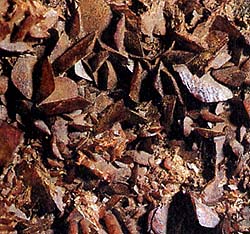 Diagnostic cart.
Diagnostic cart.
On a photo: pod lens-shaped; lenticular, lentiform brown siderite. Down: zonal siderite, associating with quartz from Uiel-modin, a peninsula Kornuoll (Great Britain).
Fe CO3
Crystal structure trigonal
Hardness on the Mohs scale 4-4,5
Specific unit weight mass 3,7-3,9
Cleavage perfect absolute
Fracture, break padman or not clear
Colors from light-yellow to black
Colors in powder triturate white
Glance (glitter, glare) glassy, pearl

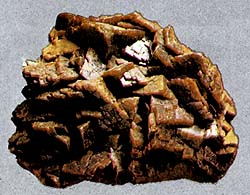 Siderite (ferrous spar) is a carbonate of iron. Glance (glitter, glare) glassy, mother-of-pear nacreous; transparent to transparent. Colors from honey-yellow to darkly-brown. A line is white, at the driven mineral - brown. Fracture, break step-uneven, rarer padman. Cleavage perfect absolute - crystals (trigonal Crystal structure) have a type of rhombohedrons. Aggregates are fine-grained, dense. Sideritovye of vein, lode, mine have a hydatogenesis. In basic sediments carbonate layers siderite forms stratal beds, sometimes with the admixture of coal and clay. Deposit minefield mine field occurrence subsoil: Zigerland (North Rhine-Vestfaliya, Germany), Eyzenerc (Austria), and also in England, USA, CIS.
Siderite (ferrous spar) is a carbonate of iron. Glance (glitter, glare) glassy, mother-of-pear nacreous; transparent to transparent. Colors from honey-yellow to darkly-brown. A line is white, at the driven mineral - brown. Fracture, break step-uneven, rarer padman. Cleavage perfect absolute - crystals (trigonal Crystal structure) have a type of rhombohedrons. Aggregates are fine-grained, dense. Sideritovye of vein, lode, mine have a hydatogenesis. In basic sediments carbonate layers siderite forms stratal beds, sometimes with the admixture of coal and clay. Deposit minefield mine field occurrence subsoil: Zigerland (North Rhine-Vestfaliya, Germany), Eyzenerc (Austria), and also in England, USA, CIS.
Siderite (chalybite, ironstone) a pale yellow to brownish-black mineral consisting chiefly of iron carbonate in hexagonal crystalline form. It occurs mainly in ore veins and sedimentary rocks and is an important source of iron. Formula: FeCO3. A meteorite consisting principally of metallic iron Fe.
Siderite is crystallized in trigonal Crystal structure. His crystals meet not too often. It is ordinary simple rhombohedrons, sometimes with the distorted verges; the crystals of prismatic type or scalenohedron meet now and then. Shpatovidnye the masses, and also concretionary, grainy or глобулярные and kidney-shaped reniform formations, are ordinary enough. Colors hesitates from inconspicuous-yellow to brown and almost black at strongly марганцевистых differences. Siderite transparent or transparent; brilliance - glassy to pearl. He is enough hard and heavy, possesses good cleavage on a rhombohedron, fragile, has a padman or not clear fracture.
Chemical composition (chemistry, compound). Protoxide of iron (FeO) 62,1% (Fe 48,3%), dioxide of carbon (CO2) 37,9%, the admixtures of MnСОз, Sasoz and MgCO3, are often present. Form of crystals. Uploschennye rhombohedrons; the verges of crystals of lentiform are bent. Crystalline structure. Analogical the structure of Calcite. Class of symmetry. Ditrigonal'no-skalenoedricheskiy - Zm. Cleavage. Perfect on a rhombohedron (1011). Aggregates. Dense, grainy, continuous the masses, also radiant formations, spherulites (pennystone, clay siderite).
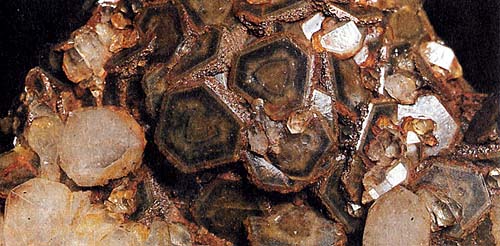 Crystals are simple rhombohedrons usually, with saddle-type curvature of verges, more frequent there are sparry rough- or short-grained aggregates: spherical or kidney-shaped reniform radial structures; dense, mixed with clay accumulations (clay ironstone). Cleavage perfect absolute on the verges of rhombohedron; closeness 3,7-3,9; color of yellowish-white, light-yellow, gold, grey, yellowish-brown, blue-black, black from the admixture of coal, sometimes with metallic pied oxide tint.
Crystals are simple rhombohedrons usually, with saddle-type curvature of verges, more frequent there are sparry rough- or short-grained aggregates: spherical or kidney-shaped reniform radial structures; dense, mixed with clay accumulations (clay ironstone). Cleavage perfect absolute on the verges of rhombohedron; closeness 3,7-3,9; color of yellowish-white, light-yellow, gold, grey, yellowish-brown, blue-black, black from the admixture of coal, sometimes with metallic pied oxide tint.
Easily blown away to swamp ore (pseudomorphosis of swamp ore on siderite). Boils up at the action of hot muriatic acid.
Diagnostic indication.
A mineral dissolves only in muriatic acid at heating with the active boiling up. It allows to distinguish him from brown Calcite which easily will dissolve in dilute acids and in-cold. Not melt fuse, becomes fracturing, russets and blacken (because of oxidization of iron). A behavior is in acids. Intensively dissolves in warmed-up muriatic acid.
Origin provenance genesis.
Siderite - widespread mineral, which be found in various geological terms. He can generate considerable accumulations, suitable for the industrial working off. He can be met also in low- and medium-temperature hydrothermal ore vein, lode, mines, and also in different metamorphic and magmatic rocks.
Deposit minefield mine field occurrence subsoil.
Deposit minefield mine field occurrence subsoil of commercial-size (mainly exhaust) is disposed in Bergamasko and Breshiano. Beautiful crystals act from the mineries of Brosso and Traversella, in Kanavese (a province is Turin), from the mine of Frizhido (a province is Mass-Karrara) and from the row of the Sardinian mineries, in particular case Nurra (province of Sassari). The deposits of siderite of Panashkeyra are most famous (Portugal); Ayzenerc in Shtirii and Khyuttenberg in earth of Karintii (Austria); Prshibram in Bohemia (Czekh); Myuzen near-by a city Zigen, Vestfaliya (Germany); Tevistok in Devonshire, Kamborn-redrut on a peninsula Kornuoll (Great Britain). Beautiful sparlike the masses in the cryolite deposit of Ivigtut in Greenland and wonderful crystals are famous also from Mont-sent-iler, a province Quebec (Canada).
Appears always in places without access of oxygen of air. 1. Pegmaticheskoe origin in vein, lode, mines rarely (Greenland). 2. The vein, lode, mines of ferrous spar of Zigerlanda serve as a classic example in the Rhenish Slate mountains (Germany) with layers in a to 30 m thick; other deposits - in Germany (Garc), Austria (Shtiriya, Karintiya), Spain, Slovakia, Russia (Sonth Ural); beautiful crystals met in Garce (Germany) and Kornuolle (England). 3. Bumpy sedimentary siderite is known in England (Wales), Vestfalii and Tyuringii (Germany), France. As a by-product of weathering in the area of oxidization the different appear oxides manganese from his high maintenance (to 6%).
Use, practical application, deployment.
Siderite is widely used in black metallurgy. He is obtained mainly for smelting became. Old name of siderite - sparry ironstone reflects the characteristics of type of mineral. From ancient times and to today siderite is obtained as a very important iron-stone.
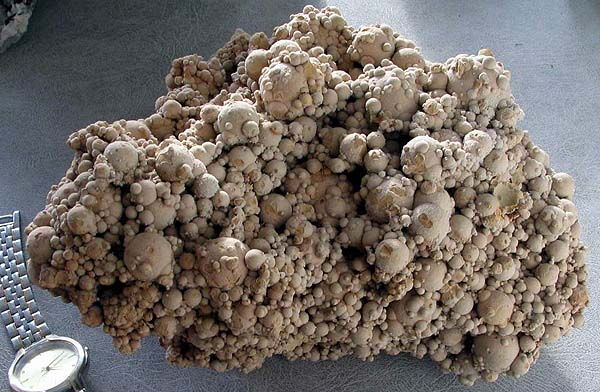
Siderite. Dalnegorsk, Seashore, Russia, CIS. A photo: © A.A. Evseev.
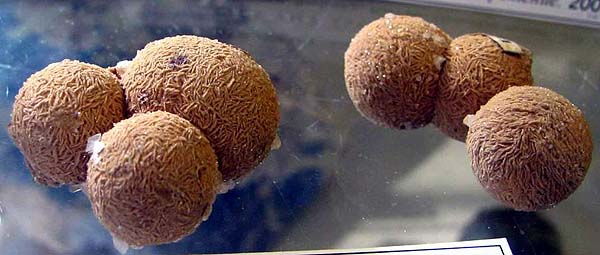
Siderite. Dalnegorsk, Seashore, Russian Federation, CIS. A photo: © A.A. Evseev.
